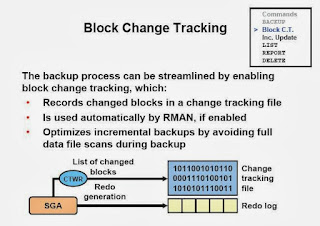My previous post was on using Groups/Priorities when specifying an alternate destination for sending Redo to a remote destination. You can find it here.
This post covers 2 topics that come up whenever I talk about alternate destinations.
- Does it balance 2 destinations with the same group/priority. and once it choses a destination, does it remain sticky to that destination and ignore other destinations with the same "group/priority"
- Does my FRA know both destinations can be considered the same for "shipped" status?
First I will show you what I configured my tests.
In my example, I actually have both a standby database and a Far Sync instance for my primary database.
bsg18 --> Primary database
bsg18d --> Dataguard database
bsg18f --> Far Sync database
This is what my 2 remote destinations look like in my configuration.
log_archive_dest_2 ='service="bsg18d" ASYNC NOAFFIRM max_failure=0 db_unique_name="bsg18d" group=1 priority=1 valid_for=(online_logfile,all_roles)';
log_archive_dest_3 ='Service="bsg18f" SYNC AFFIRM max_failure=1 db_unique_name="bsg18f" group=1 priority=1 valid_for=(online_logfile,all_roles)';
You can see that both Dataguard (bsg18d) and Far Sync (bsg18f) are in "group=1 priority=1"
Multiple Destinations with the same Group and Priority - Does it balance them ?
First I'm going to look at where the logs are going.
DEST_ID SEQUENCE# S SHI APPLIED DEL FAL
---------- ---------- - --- --------- --- ---
2 1751 A YES NO NO NO
2 1752 A YES NO NO NO
2 1753 A YES NO NO NO
I can see that they are going to DEST_2, which is my dataguard instance. I am going to shut it down, do a few log switches and see what happens.
DEST_ID SEQUENCE# S SHI APPLIED DEL FAL
---------- ---------- - --- --------- --- ---
2 1751 A YES YES NO NO
1 1751 A YES NO NO NO
1 1752 A YES NO NO NO
2 1752 A YES YES NO NO
1 1753 A YES NO NO NO
2 1753 A YES YES NO NO
1 1754 A YES NO NO NO
2 1754 A YES NO NO NO
1 1755 A YES NO NO NO
1 1756 A YES NO NO NO
1 1757 A YES NO NO NO
1 1758 A YES NO NO NO
1 1759 A YES NO NO NO
1 1760 A YES NO NO NO
I've including DEST_1 this time to show that my sequence# had moved forward, but any sending of redo my standby has stopped.
Now I started it back up, and did a few log switches.
DEST_ID SEQUENCE# S SHI APPLIED DEL FAL
---------- ---------- - --- --------- --- ---
2 1751 A YES YES NO NO
2 1752 A YES YES NO NO
2 1753 A YES YES NO NO
2 1754 A YES YES NO NO
2 1761 A YES NO NO NO
3 1755 A YES YES NO YES
3 1758 A YES NO NO YES
.....
3 1754 A YES NO NO YES
3 1752 A YES NO NO YES
3 1762 A YES NO NO NO
3 1763 A YES NO NO NO
After restarting the database, I can see that it is now using DEST_3 (my Far Sync) instance instead of DEST_2 (dataguard).
Now for a final test on this, I am going to STOP my Far Sync instance.
DEST_ID SEQUENCE# S SHI APPLIED DEL FAL
---------- ---------- - --- --------- --- ---
2 1751 A YES YES NO NO
2 1752 A YES YES NO NO
2 1753 A YES YES NO NO
2 1754 A YES YES NO NO
2 1761 A YES YES NO NO
3 1755 A YES YES NO YES
3 1758 A YES NO NO YES
....
3 1754 A YES YES NO YES
3 1752 A YES YES NO YES
3 1762 A YES NO NO NO
3 1763 A YES NO NO NO
2 1764 A YES NO NO YES
2 1765 A YES NO NO NO
2 1766 A YES NO NO NO
I stopped bsg18f (Far Sync), when it was on sequence 1764. I can see that the database automatically switched to sending logs to bsg18d (dataguard) when DEST_3 because unavailable.
This is exactly what I would expect to happen when I have 2 destinations with the same Group/Priority.
- It chooses one of the 2 destinations and becomes "sticky" once chosen.
- If the "sticky" destination becomes unavailable, it then automatically switches to the second destination.
FRA - If you use an FRA (Fast Recovery Area), how does it understand that I my redo can go to an alternate location?
Now after all this, you can see from my previous tests, some logs were sent from DEST_2 and some were sent from DEST_3. Both of these were members of the same group.
Let's see if the FRA sees them as shipped (my retention policy).
Perfect ! All the archive log space is reclaimable. When I have different remote destinations that are members of the same group, as long as the Redo Log was successfully shipped to a destination in the group, the log is eligible for deletion.
Let's see if the FRA sees them as shipped (my retention policy).
FILE_TYPE PERCENT_SPACE_USED PERCENT_SPACE_RECLAIMABLE NUMBER_OF_FILES CON_ID
----------------------- ------------------ ------------------------- --------------- ----------
CONTROL FILE 0 0 0 0
REDO LOG 0 0 0 0
ARCHIVED LOG 21.78 21.78 555 0
BACKUP PIECE 7.54 .45 38 0
IMAGE COPY 0 0 0 0
FLASHBACK LOG 0 0 0 0
FOREIGN ARCHIVED LOG 0 0 0 0
AUXILIARY DATAFILE COPY 0 0 0 0
Perfect ! All the archive log space is reclaimable. When I have different remote destinations that are members of the same group, as long as the Redo Log was successfully shipped to a destination in the group, the log is eligible for deletion.

















